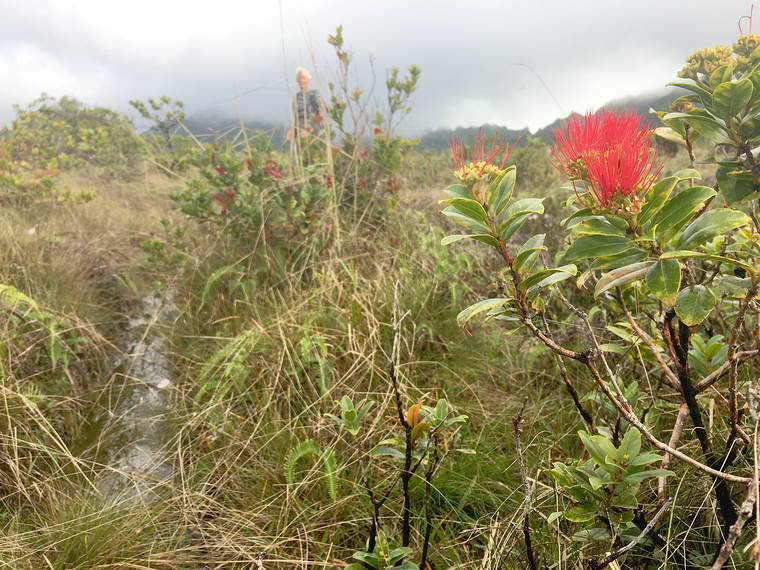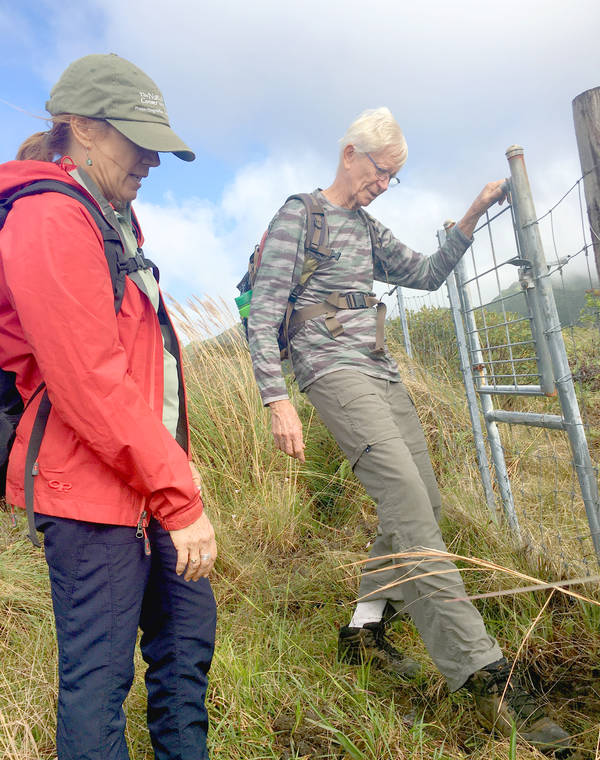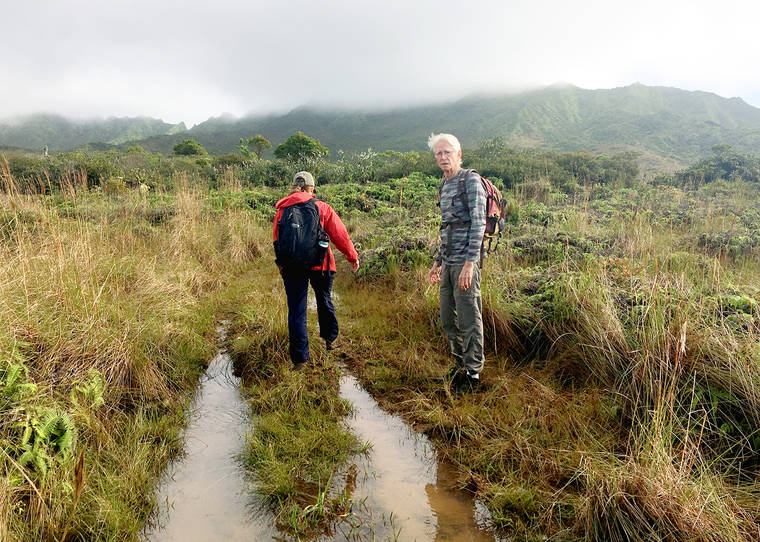KALAHEO — Water was running in peaceful streams out of Kanaele after days of rains drenched Hawaii’s last, intact, lowland bog, protected on all sides by steep mountains and the Kauai Watershed Alliance’s first predator-proof fence.
Mist hovered around mountaintops, but around the bog the sun was shining as some of the area’s caretakers — Allan Rietow and Melissa Fisher — hopped through the dense collection of low brush, fallen sticks and ohia trees.
“We’d like to get a boardwalk in here at some point for schools and small groups, but that’s going to take a while,” Reitow said, sloshing through ankle-deep mud and following little trails of water through the underbrush.
It’s a wild country kind of area at Kanaele — which literally means “bog” in Hawaiian — a place that lies at about 2,100 feet above sea level, where endemic plants and animals still thrive and where successes are being made in conservation.
Select groups do go out there, volunteers who are part of organizations removing invasive species and boosting native species in Kauai watersheds.
Rietow and Fisher are with The Nature Conservancy, which coordinates the multifaceted, invasive-species removal effort in Kanaele and other places on Kauai, under the umbrella of the Kauai Watershed Alliance.
The project helps landowners who are members of the KWA manage some of those sensitive areas, like the low-lying bog. It also brings together state and county agencies and organizations like the National Tropical Botanical Garden and Kamehameha Schools.
“Here at Kanaele, our staff and volunteers come in and remove the invasive species and we put up the fence, and then NTBG is coming back in and replanting the natives species,” Fisher said. “We all do our piece and work together.”
Alexander &Baldwin owns the land that houses Kanaele, and allows access specifically via a long and muddy road — perhaps more aptly described as a trail in some places — peppered with gates.
That jungle road has been in disrepair for years, and takes a large amount of work to maintain. It is a difficult, four-wheel-drive trek, but access to the bog is better than it’s been.
“A couple years ago KIUC (Kauai Island Utility Cooperative) had to do some work up here, so they repaired the road. While they were doing the work, we had to fly into Kanaele in a helicopter,” Fisher said. “Now, though, it’s nice because we used to have to hike in a lot further.”
That’s an advantage when it comes to maintaining the predator-proof fence, installed in 2008, that’s keeping pigs out of the bog. Several gates are installed along the fence at intervals.
On the wet, muddy ground, it’s obvious that the fence is working by the well-worn pig trails that follow the fence line on the other side of the barrier to the bog. In front of the main access gate, there’s evidence of pig rooting.
If they made it into the area beyond the predator-proof fence, the pigs would destroy the native ecosystem by rooting it up and trampling it.
“We have to be careful, too, because the baby pigs are really small and can squeeze through the fence if it’s not the right size,” Fisher said.
With a fence keeping out invasive animal species and volunteers removing invasive plant species like guava and melastoma, the bog is flourishing.
Just a few steps into the area beyond the fence, Fisher found one of Kanaele’s treasures — the tiny, carnivorous plant known as a sundew, native to Kauai bogs.
That’s just one of several unique species that populate the bog. Another is the native akoko plant.
“There’s an endemic damselfly up here, and the koloa ducks come by. We don’t have any idea how many insects are up here,” Rietow said.
Kanaele is a gem not only for connecting the community and preserving rare plants. It’s integral to the health of the watershed system all the way to the ocean, impacting even the coral reefs, the duo explained.
“Native plants in these bogs have moss and lichens that collect the water, the bogs store and filter the water. If we don’t have these kinds of places, it creates erosion and affects the whole watershed,” Fisher said.
Rietow pointed out the native ohia, showing how other species are growing near the roots of the ohia tree.
“Look at this versus the guava, for instance,” Rietow said. “That guava, nothing’s growing under it, there’s no light making its way through. Without underbrush, that leads to erosion.”
•••
Jessica Else, environment reporter, can be reached at 245-0452 or jelse@thegardenisland.com.






Good job
Nice to know people are protecting these sensitive areas. Rather spend tax money on this than supporting bums and druggies.